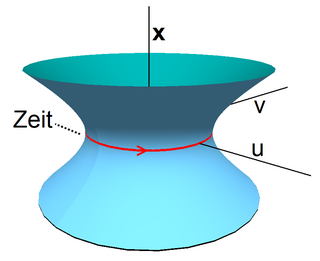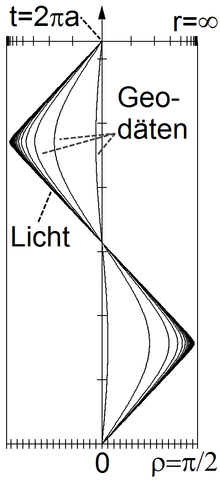Anti-de-sitter room
The anti-de-sitter space ( AdS ) is a space-time with a negative cosmological constant . The name was given as a counterpart ( positive cosmological constant) to the De Sitter space , named after the Dutch astronomer Willem de Sitter . The form of energy in the anti-de-sitter room is attractive in contrast to the de-sitter room . This corresponds to the usual effect of gravity.
The anti-de-sitter space is similar to the hyperbolic space plus a temporal dimension. In contrast to our universe , an anti-de-sitter space can neither expand nor contract - it looks the same at all times.
Despite this difference, anti-de-sitter space is proving to be very useful in finding quantum theories of spacetime and gravity . Thus the universe in the Randall-Sundrum models is a five- dimensional anti-de-sitter space.
definition
The -dimensional anti-de-sitter space is definable as the hyperboloid
with line element . Here is a -dimensional isotropic spatial vector, is a constant, is the speed of light . For constant the anti-de-sitter space consists of a circle parallel to the plane, i.e. H. time runs in a circle around the hyperboloid.
The topology of the AdS room is . The fact that time is cyclical is not a problem, as one can also use its universal overlay instead of the hyperboloid .
The intrinsic structure of the AdS space is better expressed by so-called global coordinates , i.e. H. ' For the sake of simplicity is set here . The time variable is initially -periodic. The line element becomes
where the line element is the -dimensional unit sphere .
The causal relationship of the AdS space can be seen from his Penrose diagram . This is created from the global coordinates with the help of . The coordinate compacts the radial direction on the interval , the line element is given a Minkowski shape except for a conforming factor. For applications, it is important that the edge of AdS is time-like, and thus can be used as a stage for a -dimensional physical model. Exchange of information with the infinitely distant AdS edge is possible in a finite time, the edge is therefore also physically important.
Poincaré coordinates
This type of intrinsic coordinates describes only half of the AdS space, but has a particularly simple shape for the line element. Be it . The embedding of half of the -dimensional AdS space in the -dimensional space is then given by
The line element
is conformally equivalent to the Minkowski line element. For constant time variables it is a hyperbolic space , described by Poincaré half-space coordinates .
The special physical properties
If you are floating somewhere freely in such a space, you have the impression that you are at the bottom of a gravitational potential : every object that you hurl away returns like a boomerang . It is even more surprising that the time to return does not depend on the force of the throw: the object will move further away on its round trip the more momentum you give it, but the return time always remains the same. If you send out a flash of light that consists of photons with the maximum possible speed, it moves away infinitely far and still returns in a finite time. The reason for this strange phenomenon is a kind of time contraction that increases with distance from the observer.
Geometric properties
The -dimensional anti-de-sitter space is a Lorentz manifold of constant negative section curvature .
Its isometric group is .
Its edge at infinity can be identified with for .
The anti-de-sitter room and the holographic theory
If we approximate hyperbolic space by stacked disks, then the anti-de-sitter spacetime is like a stack of these disks that form a cylinder . Time passes along the cylinder axis.
The easiest way is to initially imagine the disks as two-dimensional and their edge as a circular line. However, a hyperbolic space can have more than two dimensions. The anti-de-sitter space, which most closely resembles our spacetime with its three spatial dimensions, creates a three-dimensional projection of these "disks" as a cross-section of the four-dimensional cylinder.
In the four-dimensional anti-de-sitter space, the boundary of space - in relation to the universe - is a very large spherical surface at any point in time. The hologram of the holographic theory lies on this limit . This corresponds to the idea that a quantum gravity theory inside such a space is equivalent to an ordinary quantum field theory of point particles that is valid on the edge. If this is the case, one can use a relatively manageable “quantum particle theory” to define a hypothetical quantum gravity theory about which we know practically nothing.
See also
literature
- Ugo Moschella: The de Sitter and anti-de Sitter Sightseeing Tour. In: Thibault Damour (ed.): Einstein, 1905–2005 - Poincaré Seminar 2005. Birkhäuser, Basel 2005, ISBN 978-3-7643-7435-8 , pp. 120-134.
- Birgit Jovanović: Masses of anti-de sitter spacetimes. Dipl.-Arb., Techn. Univ. Vienna, 2008 ( PDF , accessed February 17, 2009; 477 kB)
- Carlos Barceló, Matt Visser: Living on the edge: cosmology on the boundary of anti-de Sitter space. In: Physics Letters B . Vol. 482, Issue 1-3, June 1, 2000, pp. 183-194, doi: 10.1016 / S0370-2693 (00) 00520-7 , arxiv : hep-th / 0004056 .
Individual proof
- ↑ Juan Maldacena: Gravity - An Illusion . In: Spectrum of Science . March 2006, p. 40. Retrieved January 2017.
































![{\ displaystyle \ left \ {\ left [x \ right] \ in \ mathbb {R} P ^ {d} \ colon \ langle x, x \ rangle = 0 \ right \}}](https://wikimedia.org/api/rest_v1/media/math/render/svg/7f09929eaab7d5a9f7dff10e41e426d957b70e5f)
